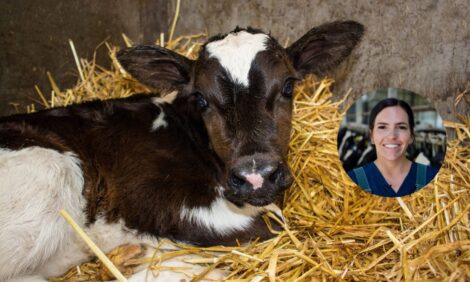



Preventing Milk Fever with Anionic Salts
Noelia Silva-del-Rio, University of California Veterinary Medicine Specialist offers up advice on preventing milk fever problems with Anionic Salts.In order to reduce the incidents of clinical and subclinical hypocalcemia, some dairies may benefit from feeding anionic salts during the close-up period. The principle behind feeding anionic salts is to acidify the dry cow diet to modify the electrical charge of the blood.
Under metabolic alkalois (positively charged blood) the conformation of the parathyroid hormone (PTH) receptors changes rendering them non-functional. As a result, the cow is unable to mobilize calcium from bone to meet the demands of lactation.
The most common cations (positively charged electrolytes) found in feed are sodium (Na+), potassium (K+), calcium (Ca2+) and magnesium (Mg2+), while the most common anions (electrolytes negatively charged) are chloride (Cl-), sulfate (SO4 2-), and phosphate (PO4 3-). A typical dry cow ration formulated with forages and concentrates will always have a positive dietary cation-anion difference (DCAD).
Adding anionic salts are the only means of achieving a negative DCAD. However, anionic salts are expensive, unpalatable, and represent an environmental concern. Their inclusion in the ration should be kept to a minimum.
Considerations When Feeding Anionic Salts
- Determine the DCAD of the dry cow diet before adding anionic salts. The level of anionic salts necessary to sufficiently acidify the diet is going to be determined by the DCAD of the dry cow diet. Most nutritionists adjust the level of anionic salts to reach a DCAD of about –50 to –150 meq/kg.A sample of the close-up ration, before adding anionic salts, should be sent to a lab for macrominerals analysis to determine the DCAD. For better results, it is recommended to use a lab that offers wet chemistry techniques.
- Reduce DCAD of the dry cow diet through formulation before adding anionic salts. Alfalfa included in close-up diets should be low potassium alfalfa or “DCAD alfalfa”. This alfalfa is grown under restricted potassium soil amendments to avoid extra uptake of potassium by the plant. Also, the combination of low potassium alfalfa and corn silage should be considered as the forage base for the dry cow ration. This approach will minimize the dose of anionic salts necessary to acidify the diet.
- Evaluate the DCAD program. The success of a DCAD program can be easily evaluated by monitoring urinary pH. In Holstein cows, urinary pH values should be between 6.2 and 6.8, and for Jerseys, between 5.8 to 6.3. If the urine fails to be acidified, evaluate if the inclusion rate of anionic salts in the diet is adequate, and if the preparation and delivery of the ration is done properly.
When to Expect Hypocalcaemia in Cattle
Cows transitioning from the dry cow pen to the fresh pen are subject to a large calcium demand in order to synthesize and secrete colostrum and milk. If calcium demand exceeds the calcium available in plasma, cows may end up suffering milk fever, also known as hypocalcemia.
Results from the 2002 National Animal Health Monitoring System (NAHMS) survey indicated that clinical hypocalcemia incidence in US herds was 5 per cent , and subclinical hypocalcemia was 25 per cent for primiparous cows, and between 41 per cent to 54 per cent for multiparous cows.
There are important physiological consequences of hypocalcemia, as calcium is essential for muscle contraction as well as immune function. Clinical hypocalcemia has been associated with dystocia, uterine prolapse, retained placenta, endometritis, compromised fertility, mastitis, and reduced rumen and abomasum motility. Similarly, cows with subclinical hypocalcemia have a greater risk for metritis, displaced abomasum, and culling.


